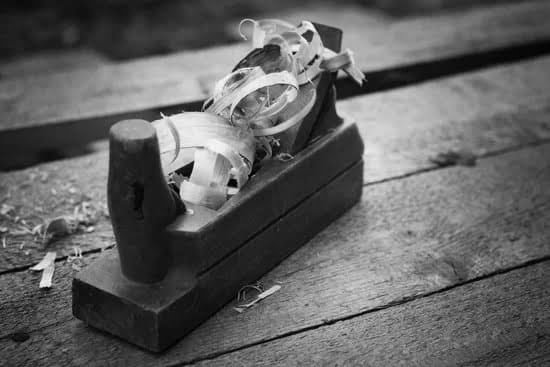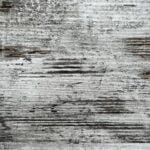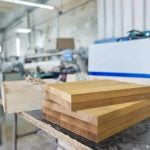Introduction
A scarf joint is an ancient technique used in woodworking to join two pieces of timber together at an angle. This type of joint has been used since antiquity and was popularized early on by shipbuilders. The scarf joint has since become a cornerstone of woodworking, providing strength, stability and versatility to the craft.
The scarf joint takes advantage of one of woods’ core attributes: it’s ability to adhere across grain. The technique involves cutting both ends of the timber at an angle, typically 45 degrees or greater, then joining them together with easy-to-use fasteners such as glue and nails. This allows workers to create a strong, long-lasting angle while taking advantage of the properties that give wood its strength, richness and character – all without complicated hardware or welding tools.
This technique not only provides a strong join between two pieces of timber but also helps improve the aesthetics of the piece. For example, with just one extra step you can taper a leg for a table or chair so that it looks elegant yet still supports substantial weight. Scalloped edging can also be created with shaved curves across the surface for attractive moldings and accents. In addition, because most scarf joints are visible from either side, they can provide interesting contrast when combined with other styles of joinery like Halved Joints or Mortise & Tenons.
Overall, the scarf joint is both an effective woodworking method as well as aesthetically pleasing while still representing traditional craftsmanship techniques. Its versatility lends itself well to modern design needs and adds that special touch that only handcrafted furniture offers!
Techniques
Scarf Joint woodworking techniques involve joining two pieces of wood together by means of an angled cut. This is done in order to increase their strength and create a smoother, more aesthetically pleasing joint. Scarf joints are found all across various types of furniture including tables, chairs, and chests.
The most common approach to constructing a scarf joint involves cutting the ends of each piece of wood at an angle, then gluing them together so that the angled surfaces fit flush against one another. The two pieces are then held together with screws or nails until the glue has dried. If a better finish is desired, dowels or biscuits can also be used to help hold the pieces together while keeping them in alignment with one another. To ensure the best fit possible, planes and chisels are often employed to help ensure a perfectly flush joint line.
Using specialized jigs can help make scarf joints easier tocreate; these jigs typically consist of two fences that keep the workpiece aligned at a fixed angle for successive cuts. With this method it’s possible to quickly produce consistent, strong scarf joints with minimal risk of error. Furthermore, power jointers or routers can be used to slice the end grain base much faster with reduced user fatigue when compared with traditional hand-try methods.
Finally, several varnish and sanding techniques are available to put a perfect finishing touch on the scarf joint after it is assembled and glued together; these may include oil-based waxes coupled with steel wool polishing and other advanced sanding methods like orbital sander use for achieving ultra smooth surfaces for an even better aesthetic look dependent upon individual preference.
Benefits
Scarf joint woodworking is an effective way of connecting two pieces of wood together to make a single structural unit that can then be used for a variety of applications. The scarf joint combines the strength and stability of the original lumber pieces, while at the same time providing increased design flexibility when building projects.
One advantage to scarf joints is that they allow for much longer lengths than what can be achieved with traditional methods such as rabbetting or splicing. This makes it possible to build larger project elements such as sturdy shelves or tables where strength requirements are greater and working space more limited. The tapered nature of the cutting also allows for code-compliant structural loading in most applications and allows repeatable geometric shapes more easily compared to other connections.
A scarf joint also provides a smoother transition between two pieces of wood, which eliminates sharp corners that need to be rounded, sanded, and otherwise trimmed down to match each piece’s shape and meet analysis standards. By properly matching the tapers on both ends, there are fewer visible discrepancies between the two non-matching boards, making it aesthetically pleasing as well as structurally sound and versatile.
Using a scarf joint requires some practice but should ultimately save labor hours and money when producing large projects like cabinets or long counter tops. When done correctly, it will give furniture makers and carpenters much more freedom to create visually pleasing works from their material stockpiles.
Applications
Scarf joint woodworking is a technique often used in furniture making and carpentry projects. It involves joining two pieces of wood together using a tapered cut that will fit the curvature of the wood, allowing it to run uninterrupted between the two separate materials. The technique creates a very strong bonding between pieces, as long as it is properly executed.
When applied creatively, scarf joints can be used to make furniture with interesting designs and shapes, from simply adding curves or angles to traditional style pieces to building more abstract forms. In musical instrument construction, such as guitars or violins, scarf joints are commonly found due to their ability to curve without interruption along the edge of an instrument’s body while providing sound integrity. This makes them ideal for connecting fingerboards and other components that need to have an uninterrupted edge profile. Additionally, they are perfect for decorative puzzle-like joinery found in boxes and cabinetry projects due to their uniform connectors.
For smaller woodworking applications such as spindle turning or miniature objects requiring intricate details, tiny scarf joints are often employed to secure delicate sections that would otherwise not be joined successfully without glue or fasteners. This allows delicate wooden parts to form intricate shapes while simultaneously being incredibly strong with the joint holding them together securely. Furthermore, because of its strength whilst remaining inconspicuous during assembly, the scarf joint has even been used in model railway engineering where it is needed for its structural integrity in curved sections yet still remain unobtrusive when viewed from above track level.
Tools
Tools For Scarf Joint Woodworking:
1. Table Saw – The table saw is meant for making precise angled cuts for a scarf joint. It’s important to make sure the blade is sharp, and to use a good quality fence that can be adjusted accurately.
2. Chisel – A chisel is used in joinery to carve out a precise fit between the scarf joint parts, ensuring the joint is snug when fastened together.
3. Drill and Screwdriver- A drill and screwdriver bit set will come in handy if you wish to use screws instead of nails or dowels to secure your scarf joint woodworking project. A good quality countersink bit will help you set the screws without piercing through the wood’s surface.
4. Clamps – Clamps are always essential when working with wood, as they can be used to secure the parts of your scarf joint while they are being assembled, while also providing pressure on difficult joints until glue sets up properly.
5. Block Plane – In order to achieve a perfect finish along a scarf joint, a block plane may be necessary for smoothing down any sharp edges or rough surface finishes that may be created during the cutting process. This will help ensure each side of the joint has an aesthetically pleasing look once it’s been assembled together.
6. Dowel Jig- If you choose not to use screws when creating your scarf joint project, then a dowel jig may be necessary; this allows for any dowels used in lieu of screws to hold strong and precisely placed throughout the assembly process.
Safety
When using scarf joint woodworking for joining timber, there are a number of safety considerations to be taken into account. As in any kind of carpentry, it all starts with the proper clothing and gear – long pants, sturdy shoes, and eye protection are essential.
When laying out the pieces for the joinery, always use clamps or set screws to hold them securely in place and always use straight edges to make sure everything is aligned properly. When cutting or routing joints, always use guards and dust extraction systems on power tools as well as push sticks when hand-sanding. Care should always be taken to keep your fingers away from blades, saws and sanders. Finally, always wear a dust mask when working on larger projects with lots of sanding and chiseling – the small particles can cause respiratory issues over time.
By following these basic procedures you will help ensure that you stay safe while carrying out this craft. Sticking to best practices should help prevent issues like trips, slips, falls and lacerations so stand firm on safety while scarf joint woodworking!
Tips
Scarf joints are an essential woodworking joint used to join two pieces of different lengths, thicknesses, and grain orientations. When done correctly, it produces a smooth connection with excellent strength, making it ideal for joining dissimilar woods or woods that have been exposed to different climates. However, creating perfect scarf joints requires great accuracy and skill and is often difficult for novice woodworkers. Here are some expert tips and tricks for creating flawless scarf joints and preventing common errors:
1) Measure Twice: Before you begin cutting the scarf joint, double check the measurements of your materials to ensure they line up correctly when put together. This will help you avoid mistakes such as mismatched angles or misaligned plates that can ruin your final product.
2) Use a Miter Saw or Band Saw: Using tools like miter saws and band saws can make the process much easier by ensuring precision cuts every time. Be sure you have sharpened blades in order to get the best results from these tools.
3) Use Glue: Applying glue helps keep your pieces firmly connected and strengthens the joint even further. Make sure you apply an even coating of glue on both mating surfaces before assembly for maximum adhesion.
4) Apply Wood Filler: After assembly, carefully fill any gaps between the pieces with wood filler before sanding or finishing. This will ensure a perfectly smooth joint that looks great after painting or staining.
5) Finish Off with Sandpaper: Sanding your finished joint with fine-grit sandpaper will help create a truly polished look that’s ready to show off!
Examples
Scarf joint woodworking is a type of craftmanship that involves joining two pieces of wood together without using traditional butt joints. This kind of joint is also known as a scarf cut, lapped joint, or skiving joint. Scarf joints don’t require overlapping surfaces in their design and use angled cuts to make an interlocking piece. This technique allows for stronger connections than with typical butt joints and permits movement due to the wood expansion and contraction experienced during changing temperature and humidity levels.
The most popular uses for scarf joint woodworking are trim moldings, furniture frames, ornamental roofs, mantels, and cabinet faces. There are various techniques when it comes to creating scarf joints: hand cutting with a chisel or hand saw by angling the cuts at 45° or 60°; sloping gouges used for making smooth angled surfaces; router bits which provide uniform depths in cuts; circular saws with adjust tilt angles which can create more complex designs; and dovetail jigs that can be set up quickly. All these methods aid in constructing accurate scarfing profiles and help create efficient joinery between different pieces of materials. When done correctly, scarf joints offer strong support, beautiful visuals, and better protection against deterioration due to water ingress.
Conclusion
Scarf joint woodworking is a great way to create amazing woodworking projects. It offers numerous advantages, such as cost efficiency, easy repairs and replacements, strength, and flexibility to adapt a project to different shapes and styles. With scarf joint woodworking, projects can be made with higher precision and little material waste. Its joints are extremely durable due to the overlapping of pieces at steep angles that create interlocking tension, making them highly resistant to impacts or extreme temperatures. Furthermore, scarfed pieces easily blend in together forming a seamless look with grain patterns that run along the entire project without interruption. This creates aesthetically pleasing effects on any craftsman’s work while offering stronger end results than traditional methods of computer-cut joins. In addition to these advantages, scarf joint woodworking also allows for quicker construction times which increases savings in labor costs and materials used. Consequently, its overall efficiency makes it an excellent choice for ensuring successful woodworking projects that stand out among others.

Hi everyone! I’m a woodworker and blogger, and this is my woodworking blog. In my blog, I share tips and tricks for woodworkers of all skill levels, as well as project ideas that you can try yourself.





